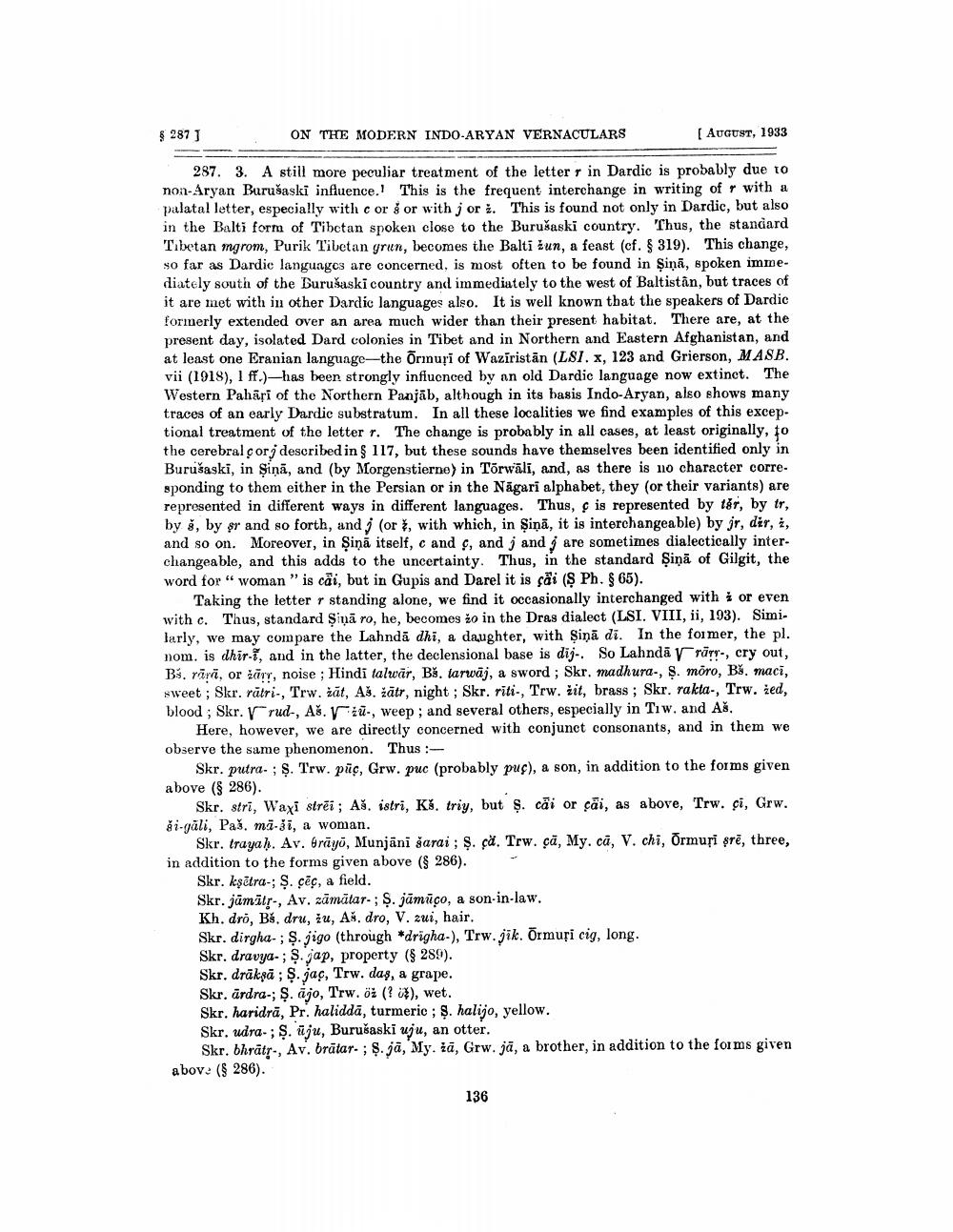________________
§ 287 J
ON THE MODERN INDO-ARYAN VERNACULARS
[AUGUST, 1933.
287. 3. A still more peculiar treatment of the letter r in Dardic is probably due to non-Aryan Burušaski influence. This is the frequent interchange in writing of r with a palatal letter, especially with c or & or with j or . This is found not only in Dardic, but also in the Balti form of Tibetan spoken close to the Burušaski country. Thus, the standard Tibetan mgrom, Purik Tibetan grun, becomes the Balti žun, a feast (cf. § 319). This change, so far as Dardie languages are concerned, is most often to be found in Sina, spoken immediately south of the Burušaski country and immediately to the west of Baltistan, but traces of it are met with in other Dardic languages also. It is well known that the speakers of Dardic formerly extended over an area much wider than their present habitat. There are, at the present day, isolated Dard colonies in Tibet and in Northern and Eastern Afghanistan, and at least one Eranian language-the Ormuri of Waziristan (LSI. x, 123 and Grierson, MASB. vii (1918), 1 ff.)-has been strongly influenced by an old Dardic language now extinct. The Western Pahari of the Northern Panjab, although in its basis Indo-Aryan, also shows many traces of an early Dardie substratum. In all these localities we find examples of this exceptional treatment of the letter r. The change is probably in all cases, at least originally, to the cerebral corj described in § 117, but these sounds have themselves been identified only in Burušaski, in Ṣiņā, and (by Morgenstierne) in Tōrwäli, and, as there is no character corresponding to them either in the Persian or in the Nagari alphabet, they (or their variants) are represented in different ways in different languages. Thus, c is represented by ter, by tr, by 8, by sr and so forth, and j (or, with which, in Sina, it is interchangeable) by jr, dir, i, and so on. Moreover, in Ṣiņa itself, e and c, and j and j are sometimes dialectically interchangeable, and this adds to the uncertainty. Thus, in the standard Ṣiņa of Gilgit, the word for "woman" is cai, but in Gupis and Darel it is çai (S Ph. § 65).
Taking the letter r standing alone, we find it occasionally interchanged with or even with c. Thus, standard $ina ro, he, becomes žo in the Dras dialect (LSI. VIII, ii, 193). Similarly, we may compare the Lahnda dhi, a daughter, with Sina di. In the former, the pl. nom. is dhir-, and in the latter, the declensional base is dij-. So Lahnda Vrary-, cry out, Bs. rārā, or žary, noise; Hindi talwar, Bs. larwaj, a sword; Skr. madhura-, S. moro, Bă. maci, sweet; Skr. ratri-, Trw. zat, Aš. žatr, night; Skr. riti-, Trw. žit, brass; Skr. rakta-, Trw. żed, blood; Skr. Vrud-, Aš. Viu-, weep; and several others, especially in Tiw. and Aš.
Here, however, we are directly concerned with conjunct consonants, and in them we observe the same phenomenon. Thus :
Skr. putra S. Trw. puç, Grw. puc (probably puç), a son, in addition to the forms given above (§ 286).
Skr. stri, Waxi strei; Aš. istri, Ks. triy, but S. cai or cai, as above, Trw. çi, Grw. ši-gali, Paš. ma-ži, a woman.
Skr. trayah. Av. Grayō, Munjäni šarai; S. ça. Trw. ça, My. ca, V. chi, Ormuri sre, three, in addition to the forms given above (§ 286).
Skr. ksētra-; S. çeç, a field.
Skr. jämätṛ-, Av. zämälar-; S. jāmāço, a son-in-law.
Kh. dro, Bs, dru, zu, Aš, dro, V. zui, hair.
Skr. dirgha-; S. jigo (through *drigha-), Trw. jik. Ormuri cig, long.
Skr. dravya-; S. jap, property (§ 289).
Skr. drākṣā; S. jac, Trw. das, a grape.
Skr. ärdra-; S. ajo, Trw. öz (?), wet.
Skr. haridra, Pr. halidda, turmeric; $. halijo, yellow.
Skr. udra-; S. uju, Burušaski uju, an otter.
Skr. bhrātṛ-, Av. brätar-; S. ja, My. ia, Grw. ja, a brother, in addition to the forms given above (§ 286).
136




